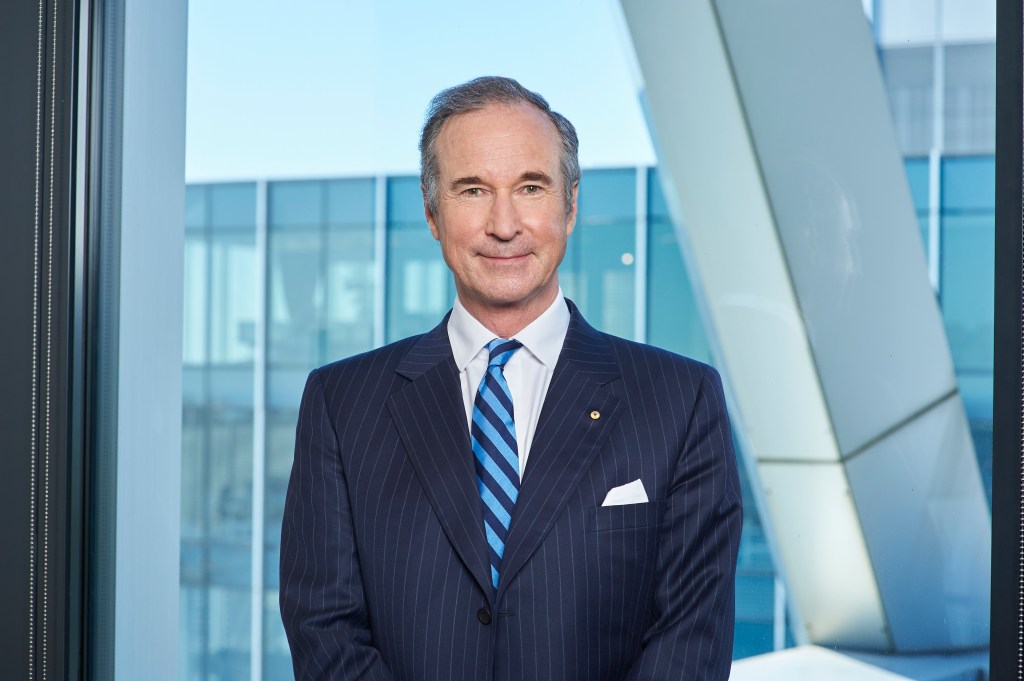Tim Sims, co-founder and managing director of Pacific Equity Partners [PEP] – with $9 billion AUM, talks to Forbes Australia’s managing editor Stewart Hawkins about public versus private equity, the debt market, interest rates, why investing in startups isn’t what the firm does, the future of deal cadence and whether we’re now in a “difficult” investment market.
Given the craziness of the past few years, what do you see as the advantages of private equity over public in a volatile market?
Private equity has become an attractive investment class for sophisticated investors globally. Large endowments or family offices might have as much as 50% of their funds in alternatives or private equity. Public equities have a long and well-documented history – we have 300 years of data coming out of the Dutch exchange, a couple of hundred years out of London and more than 200 years from New York.
Against a background of 3% long-term inflation, which has been the average over 100 years or so in the US market, public equities, which are 60% of global listed value, have produced long-term returns of between 6% and 9%, which is not unattractive.
However, the volatility around those returns is significant. Listed equities have constraints in an environment where market sentiment is a powerful influence. We also know there have been real tensions over how management incentives align with maximising shareholder value over the long term. If management and boards are dominated by short-term results and expectations, often long-term potential is neglected, and ‘satisfactory underperformance’ can become the norm for listed companies.
So, what about investments in the debt market?
The bond market is the most tradeable part of the debt market and is the traditional portfolio complement to public equities. Over the long term, bonds have run at a 2% to 5% return level. In a traditional blended 60:40 portfolio, this results in a couple of hundred basis points above long-term inflation. On the face of it, the bond return is attractive because returns are less volatile and risk exposed than equities.
They do, however, have an Achilles heel, which is that in most bond constructs, the face value of the bond is immediately sensitive to the interest rate on the bond itself. So, if interest rates are volatile or move significantly in any direction, there can be profound effects on the face value of the bond portfolio. What should be a safe and conservative instrument becomes uncertain in an environment where interest rates are unpredictable. The traditional mantra is that “nobody ever lost money on a bond they hold to maturity.” The reasonable response, though, is, “Yes, as long as you’re not forced to mark to market on that journey.”
So back to private equity?
Private equity is often used as a very broad term. There are many different risk profiles and product offerings that sit under that umbrella. There has been, for example, much angst around declining tech valuations, which has raised questions and uncertainty in a world where VC or venture capital and private equity are used almost interchangeably. The space in which Pacific Equity Partners traditionally operates is characterised by old-fashioned ‘leverage buyouts’ of significant and well-established businesses.
We should properly define these investments as leverage with a small L. Typically, our leverage has not been much more than 50% of the capital structure, which happens to be the blended average of all listed companies. We are private capital intent on paying a ‘full and fair’ price for a company and yet seeking to make substantial returns for fund investors – net of fees.
“The differences between the best and worst performance in the private equity buyout space is profound.”
Traditional wisdom says the number they’re aspiring to is a net 20% annual return. This target reflects a generous premium for the less liquid nature of the investments; capital is called and maybe put to work for the full cycle of any individual investment. Typical initial hold periods might be between 3 and 6 years.
The differences between the best and worst performance in the private equity buyout space is profound. In public equities, the difference might be a few percentage points only. In a private equity buyout however, the difference could be more than 20%.
What’s fascinating in the discussion we’re having about the relative volatility and returns of public equities and the structural challenges of the bond market is that the top quartile performers in private equity buyouts over the past 20 years have produced a pretty steady 17% net annual returns.
This is why large, sophisticated investors that can access those funds have such substantial allocations to this space. PEP’s average net annual returns after more than 25 years have been 30% or more than two times the money on each fund.
So how do you achieve that?
The average growth rate of the profits of the businesses we buy is 5% per annum. Australia’s average GDP growth rate over the period we’ve been operating has been a record-breaking 3% per annum. So, the companies we’re buying are growing their profits only at a modest premium to GDP. By contrast, over the past 25 years, we’ve seen the profits of our invested companies increase on average by 95% during our holding period, typically 3 to 6 years.
So, you have companies that have been growing profits at 5% and are now delivering 25% consistently and regularly across the portfolio over time. Contrary to popular myth, this needs to be high-quality diligence-able profit with a clear upside for the next owner.

A prerequisite for consistent outcomes is the choice of robust industries and businesses that are not exposed to large, unpredictable external pressures, such as radical changes in regulation and large swings in commodity prices because all you’re doing there is betting on an external risk that could go either way.
Invest in goods and services essential to customers and clients and then do three things: have a clear idea of the company’s full potential through deep diligence; introduce a set of incentives that encourage management to drive hard for that potential, and find extraordinary managers, who will do this in a supportive and battle-tested environment. All of these things are easy to describe but demand years of experience, deep apprenticeship and a culture of mutual support.
The PEP experience has sustained gross returns above 40% per annum, with a level of consistency that sits outside the normal risk-return spectrum.
No investment is entirely risk-free, so what is the most challenging aspect for PE?
Typically, our investments produce between two and three times the money’s gross returns. We have had a few painful experiences where it’s gone the other way, and they’ve always been for the same reason; we have underestimated the influence of major external changes that we thought we were insulated from. Each time they occur, which I am pleased to say has not been often, the unexpected external influence has been different, but the lesson is the same. It is reassuring to see zero loss ratio over the past decade as we seek to learn and improve on what we do.
Regarding volatility, when talking about externalities, are we in a challenging place now?
The first thing to say is that macroeconomic insight is not an area of specific expertise for us and is certainly wide open to the unexpected cross currents that we have just spoken about. We will be investing as we have through previous cycles and assuming that the present answer to these future questions is unknowable.
Having said that, there has been much commentary over the past year about the dangers of breakout inflation and even stagflation, and some famous global commentators have warned that that’s where we are all going. You can see the effect it’s had on the popular psyche. 57% of Australians, according to the polls, are concerned that there might be a market crash this year. And then, of course, in the medium to longer term, there’s geopolitical risk, the emerging challenge of a profound demographic shift, and the economic stress of a wholesale shift in energy supply, to name the more obvious. The business question is, where will any specific asset go in this environment, and is the business model robust enough to sustain a purchase price that will satisfy the vendor?
As of June last year, most of the indicators on supply chain pressures causing the price increases and delays in delivery seem to have eased. We’ve seen the COVID pressures, particularly when China locked down, beginning to ease. And we’ve seen progress on headline inflation fighting by reserve banks around the world.
It looks as if we’ll end up in a world where structural inflation will be higher than the levels that we’ve been seeing targeted at around 2%. It may be more like 4% inflation, which is not dangerous unless it’s volatile. Reasonable levels of steady inflation are good for the national psyche. Ironically, they encourage a sense of growth and forward momentum.
So, is it bad? I think it’s seen to be worse than it probably is. I think we’re past the worst.
Where I'm putting the money
What has this meant for deal volumes and market prices for companies?
The stock exchange forward PEs are currently a little below 5-year averages, although this masks significant shifts in underlying sector values. Pricing has tended to be more sensitive to circumstance, if not more modest, and leverage is still there at similar margins over higher base rates. Deal volume over the past 12 months has been more subdued. In 2022 in the Asia Pacific at large, the volume of deals was down by more than 40%, and for China, not surprisingly because of the economic effects of COVID, they were down by over 50%.
One key driver is that most businesses didn’t feel they wanted to present their numbers when COVID was constraining their trading performance.
Low cash rates also meant that the value of cash realisation for corporates was reduced. All of that has now begun to change.
We see early signs of a significant shift coming through the deal pipeline, as we have seen before after a period of more constrained vendor behaviour.
What does this mean for Australia moving forward?
We are probably looking at GDP growth in that 1.5% to 2% range, down from 3%. We have record migration planned. Nearly 80% of the economy is a domestic product for domestic consumers. A little over 20% of the economy is the export of best-in-class commodities to adjacent markets. The big ones for Australia are iron ore, coal, gas and gold.
So, we have a privileged economy. We’ve described it as a ‘first-world new economy’. The private equity returns in this market have been markedly above the average for global markets.
How do you identify new opportunities, and where the deal flow may come from?
A significant portion of the deal flow comes from ‘corporate carve outs’ or non-core company divisions. At one level, they have a counterintuitive starting position: they’re well run, often by solid managers, and may have well-respected brand names, but they are sitting in large complex portfolios under an incentive system, with investment support and ownership structures, which may not mitigate to the highest value. So, changing the ownership structure can release value for both sides. It allows the seller to achieve a price they couldn’t reach otherwise and enables the buyer to pay a full and fair price and continue to deliver substantial value for subsequent owners.
And if you ask the traditional question, “Is it not then a dangerous thing to sell to people who end up adding a lot of value? Is that not something you should feel self-conscious about?” Well, in the first instance, no, you’re getting the best price on the night. However, in the second instance, if that is a consideration, you would do well to structure the deal as a joint venture.
A second potential area for deals is ‘public to private’ transactions. The convention
is that you pay a substantial premium to de-list a company. This needs to be approached with diligence and care by all parties because you can create unhelpful market dysfunction. If parties are respectful and experienced, and the deal is well thought through, it should be possible to establish, under full and proper regulation protection for shareholders, a reliable outcome for shareholders with board approval. It’s a complicated thing to execute, but a board that encourages the market to realise that their stock is worth more than it is currently trading at is certainly one that would be well advised to think about having a real-life external valuation and a real commercial bid for their business.
We’re not talking about hostile takeovers here; that’s different. That’s a corporate raider thing, and the risk for everybody in that model is much higher.
We’re talking about genuine situations where the ownership structure for a particular business would be better private. We have concluded eight of these. The third category is ‘private sellers’. These are people or families that own their own businesses.
They tend to be understandably keen to get a one-off, best-ever price for the business they’re selling. It might be that the private company wants to go through a major transformation, take money off the table now and go on to invest in doubling or tripling the size of the business, having ensured that the family wealth is safe before they do that, but also participating in the upside.
How much is available in these three areas? Is there a volume you can buy?
There is a sense in which ‘public companies’ are always for sale, and there’s a price at which every public company should sell. The real business question is about when the company will benefit from a new ownership structure. Opportunistic bids are not particularly welcomed by boards with good reason and sound logic. What is a productive strategy is to see a listed business where both the board and the potential investors agree that, with a different set of constraints, it could be made more valuable.
That phenomenon hasn’t changed much in the public company sector. If anything, public companies are more wary now because recent trading has been uncertain.
In the ‘carve-out space’, historically, in a low-interest rate environment, there was very little value to cash for corporates. You might sit with an asset longer than needed because you couldn’t use the cash. You’d sell a business if you thought you would get a great price and could redeploy the cash elsewhere, but if you sold a business and all you got was cash, the next question that shareholders would ask is, ‘can we have the money back?’
With higher interest rates, headwinds a little stronger, and the pressure to be efficient and properly configure your portfolio to satisfy investors or refinance debt, you would expect to see non-core businesses coming to the market again.
You might see some countervailing pressures from vendors thinking they aren’t going to get a good price because interest rates are high, but that’s not necessarily true. Debt is still available at long-term equivalent prices, and professional buyers are hungry.
With ‘private sellers’, it’ll depend a little bit on how their business travels in the current environment.
In general, this has meant a slowing in the deal cadence over the COVID years. Most businesses were keen not to be seen because their numbers weren’t looking as good. The result is a general sense in the industry that there is dry powder around.
Do you see that cadence increasing?
The past 18 months have seen below-average cadence. You had economic uncertainty, which generally causes vendors to be cautious and hold back. They’ve got one transaction to do, and they want to ensure they do it in optimal circumstances. There’s a natural rate at which deals come to market. And when you see a more constrained activity, that’s often followed by a period of robust activity.
Finally, why does your firm eschew buying startups or new companies?
We start with businesses operating well but not at their optimal levels for sound, diligence-able reasons. We choose to step around businesses vulnerable to significant external uncertainty that we can’t control. Our focus is on consistent, repeatable results across every investment. It is helpful to see that come through in data. For example, every investment made in our Private Equity and Secure Assets strategies between 2010 and 2020 has now been exited and has generated a set of strong outcomes with zero loss.






